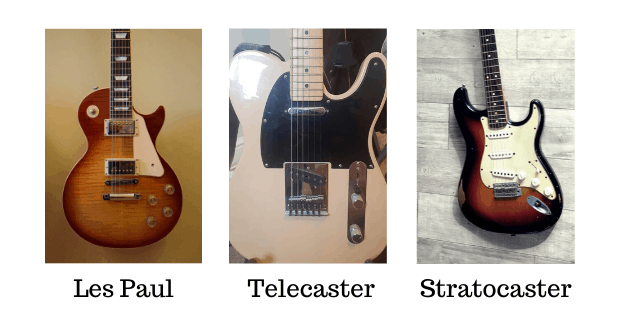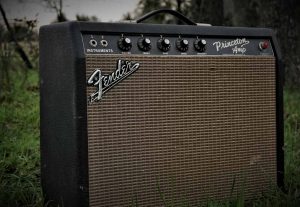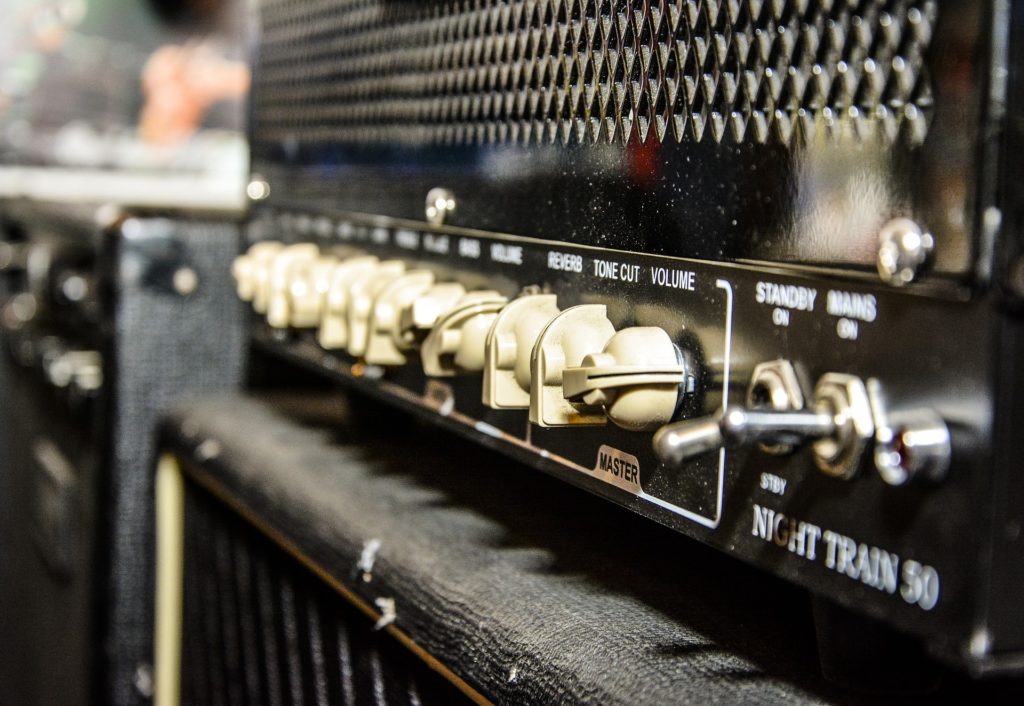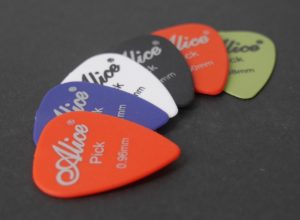Are you looking to start playing the electric guitar, but not sure what you really need?
In this post I’ll go through all the equipment and accessories you need, dividing them into essentials and non-essentials so you can get started asap!
To play the electric guitar, you will also need an amplifier, a cable to connect your guitar and amp, and some picks. Other useful accessories include, a guitar strap case, tuner and capo. and stand. Purchasing some strap-locks is also recommended if you will be playing whilst stood up.
What do you need to play the electric guitar?
The Essentials
- An amplifier
- A cable to connect your guitar and amp (Amazon link)
- Some picks (Amazon link)
Other Useful Accessories
- Strap (Amazon link)
- Strap locks (Amazon link)
- Case or gig bag (Amazon link)
- Tuner (Amazon link)
- Capo (Amazon link)
- Guitar stand (Amazon link)
- Effects pedals
The Electric Guitar
Okay, so you’re no prizes for guessing that this would be on the list. But if you’re new to playing electric guitar then you may not really know where to start with choosing one.
There are so many different makes, models and versions that it can be almost impossible to know which one to go for. So here’s a quick electric guitar buying guide.
Narrowing it Down
There are three main things you need to consider when choosing an electric guitar.
- Sound
- Feel
- Looks
All three are really important. You need to choose a guitar that sounds good to you and has a great tone.
But you also need to make sure it feels right. Is it too heavy? Is the neck comfortable? Can you easily sit and stand with it? These are all important questions, especially for a beginner.
Some guitarists may think that considering the looks as a priority is a bit shallow, but I think it’s really important. If it looks good, you’ll probably play it more.
So don’t choose something that you’re not really struck on in the looks department, because it can actually make a difference to how much you practice.
Elements of the Electric Guitar
Now there are several things that dictate the sound, look and feel of an electric guitar. Here are the most important things to consider:
- Body shape: most electric guitars have either a single or double cutaway design. There are also some more unique shapes like the Flying V. These shapes affect how the guitar both looks and feels.
- Body Type: there are three main types: hollow, semi-hollow and electric. Hollow guitars sound more acoustic, and are less capable of handling distortion than solid body guitars. Take a look at this post on the main guitar body types to learn more.
- Pickups: these are responsible for detecting the sound of the strings. Different pickup types can produce very different tones. There are three main types: single-coil, P90 and humbucker. Single-coils sound brightest and are great for clean tones, whilst humbuckers are darker and great for heavier genres, P90s sit somewhere in between the two. Check out this post on the different pickup types to learn more.
- Bridge: this is acts as the end point for the strings on the guitar’s body. There are two main bridge types: floating and fixed. Fixed bridges are easy to use, whilst floating bridges are more complicated but allow you to add a vibrato effect. Check out this post on the different bridge types to learn more.
- Neck: different guitars have different neck shapes. Some electric guitars have thicker necks that have a deep rounded back, whilst others are thin. The thinner the neck, the easier most players find it to move around the neck quickly and play faster. But others find them too thin and prefer something a bit weightier. It’s all personal preference.
- Tone wood: the different wood used on the fretboard, body, and neck, all affect how the guitar looks, sounds and feels. Take a look at this post on electric guitar tone woods to learn more about this topic.
- Other important features are: the scale length, volume and tone controls and the strings.
Main Electric Guitar Types
There are several main electric guitar types that a lot of guitars are based around. These are:
- S-Type (Stratocaster): normally uses 3 single coil pickups, has a double-cutaway body and produces a bright and sharp sound.
- T-Type (Telecaster): has a single cutaway body, with two single coil pickups. It’s a versatile guitar that is used for anything from jazz to metal.
- L-Type (Les Paul): this is a single cutaway design, with two humbucker pickups
- Superstrat: this is basically a Stratocaster that’s built for heavier genres like metal. Take a look at this post on Superstrats to learn more.
There are also several other popular electric guitar types like the Flying V, Explorer and Jaguar, Jazzmaster.
If you’re looking for a great price, then check out Guitar Center. When purchasing my electric guitar, I tried it in store but then ordered it online because the price and colour options were better.

I’ve written a complete buyer’s guide for electric guitars which takes you through all the things you need to consider and a step-by-step method to narrowing down your selection and choosing the best option. Here is a link to the article.
If you’re unsure what size guitar to buy, check out my complete guitar size guide for everything you need to know.
The Amplifier
The next thing you need to think about, is your amplifier. Of course, it is possible to play an electric guitar without plugging it into an amplifier, however it will be super quiet and sound very thin, not like an acoustic guitar.
It’s fine for practising, but if you’re not going to get an amplifier as well, then you may as well just go for an acoustic guitar instead.
Again, if you’re shopping for an amplifier, it can feel quite overwhelming because there are so many types, brands and models to think about. So here’s a quick guide to choosing the best amplifier for you.
what is an amplifier?
Amplifiers are essential if you want to be able to hear your electric guitar properly. They are connected, via a cable, to your electric guitar, and allow you to increase the volume, and change the tone that’s produced.
For example, you can usually adjust the following controls on an amplifier:
- Gain: this refers to the amount of overdrive/ distortion you hear. You can set this low to have a clean sounding tone, or crank it up for something like metal.
- Treble: this refers the amount of high-frequency sound the amp will play. The higher the treble, the sharper and crisper the tone.
- Mids: this refers to the amount of mid-range frequencies you’ll hear. Guitars provide the mid-range frequencies in most bands, so it’s a really important feature to be able to control.
- Bass: this refers to the low-end frequencies. The higher the bass, the more “boomy” the sound will be.
Combo vs Stack AMPLIFIERS
Guitar amps usually exist in two forms, either a combo, or a stack form.
A combo amp, consists of the amplfier and the speaker all together in an all-in-one design.
A stack amp, is when the amplifier and speaker are separate. They can then be connected together.
For beginners, I think combo amps are best because they’re generally cheaper, and more simple to use, plus they’re easy to transport.


Amplifier Types
The first thing you should probably consider when choosing an amplifier, is what type to go for.
The type you choose will be dependent on the tone you’re after and your price range. Here are the two main types and their pros and cons.
- Valve or Tube Amp: these are most commonly used by professionals as they have an excellent tone and are the loudest option. However, they’re quite expensive and also require more maintenance.
- Solid-State Amp: these are cheaper, lighter and easier to maintain, so are popular with beginner guitarists. However, they don’t sound quite as good as a tube amp.
Make sure you check my in-depth guide comparing solid state and tube amplifiers so you can decide which is the best option for you.
Sizes
The size of your amp will depend on what you plan to use it for. If you just want something to practise at home with, then you may only need around 20 watts. You’ll need around 30 watts or more for small gigs.
Best brands
There are loads of different amplifier brands out there, but here are a few of the most famous ones.
- Marshall: these have a classically British tone and are associated with many famous guitarists like Eric Clapton and Noel Gallagher. They’re high powered and have a gritty tone with a lot of bite and crunch as they favour treble frequencies.
- Orange: this is a British manufacturer that produces amps that are very popular with metal and hard rock guitarists. They’re punchy and powerful and have a gritty and fuzzy kind of tone. Guitarists that use Orange amps include Black Sabbath’s Tony Lommi and Led Zeppelin’s Jimmy Page.
- Vox: this is another British brand with a lot of history. The tone is a bit more smooth and subtle than Orange and Marshall amps. Queen’s Brian May, and the Beatles have sported Vox amps.
- Blackstar: this is one of my personal favourites. It’s a newer brand, however they’ve built a really great reputation. If you’re looking for an amp with a lot of extra features, then take a look at Blackstar.
- Fender: these are American made and produce a warmer tone than British amps, because they have a greater focus on the lower-mid range frequencies. They sound warm and smooth in comparison.
- Mesa/Boogie: this is another American manufacturer. These amps are great for metal and hard rock guitarists as they produce a tight and aggressive distorted tone.
In the market for a new amplifier? Check out my complete amplifier buyer’s guide to help narrow down your selection and find the perfect amp for you.
A Cable
So now you’ve got your amp and guitar sorted, you’ll need to be able to connect them together. You can do this using a cable.
There’s not much to this section, as you can find guitar cables pretty much everywhere.
However, one thing I would say, is to not skimp on the cable. You really don’t want to be purchasing anything super cheap and nasty, just because it’s a cable.
When I was first playing, I really underestimated the importance of a good cable. I was experiencing a lot of feedback and unwanted background noise with my amplifier, and though that my amp was simply not that great.
That’s until I tried a new cable, and all the horrible background noise disappeared. If you purchase a low quality cable then it’ll likely deteriorate quickly and lead to sound issues.
Check out this 10ft Guitar Cable on Amazon for a high-quality but affordable option.
As well as quality, you need to think about the shape of the cable connection.
Some are L-shaped, and others are just straight. If your electric guitar has the cable connection on the side, then go for an L-shape one, because you’re less likely to bend it when you sit down. But if your guitar has the connection point on the front of the body, then go with a straight connection.
Some Picks
So finally, on the list of essentials for playing guitar, is a pick (or plectrum). Picks are super important when it comes to playing the electric guitar, and although some guitarists don’t bother with them, I think that the vast majority of players, especially beginners, will benefit from getting them.
There are absolutely tones of different picks out there, so it can be hard to decide which one to try first.
Generally, I’d say the best thing to do is to buy a selection of picks and try them all and see what works best for you. Sometimes different picks feel best for different situations and songs.
Check out this multi-pack of guitar picks on Amazon. It includes all different sizes and thicknesses so you can try them all and decide which suits you the most.
Here’s a quick guide to guitar plectrums to give you a bit more help when deciding which to use.
Pick Thickness
There are four gauges when it comes to guitar picks.
- Thin (0.60 mm or less)
- Medium (0.6-0.8 mm)
- Heavy (0.8-1.2 mm)
- Extra Heavy (1.2 mm of thicker)
Here’s what the different thicknesses mean:
- Thinner picks produce brighter sounds, whilst thicker picks sound warmer and more mellow.
- Thicker picks require more finger strength and dexterity to be able to control them accurately.
The hardness of the pick is also important. You can get thin picks, that are made from hard material, which makes them sound and play a bit more like thicker picks.
Size
The size of your pick depends on how close you want your hands to be to the string, and also how big your hands are. The smaller the pick, the easier it will be to control. So try not to choose something really large, if your fingers aren’t actually that big.
Shape
There are all kinds of weird and wonderful pick shapes, but the most common is the tear drop shape. The sharper the point of the tear drop, the more precise it is, and it also has a brighter tone. A more rounded tear drop shape sounds more mellow and softer.
Material
There are several main materials to consider, which all impact the feel and tone.
- Nylon: this is a really common type, it’s quite soft and flexible.
- Celluloid: this is better if you want a stiffer pick.
- Metal: these are very hard and produce a twangier sound.
- Wood, rubber and leather: these are the softest kind of picks you can get.

More Accessories
Now we’ve been through all the essentials, here are some of the other things that a lot of guitarists use when playing electric guitar.
Strap
If you want to be able to play your electric guitar stood up, then you’ll need to get a shoulder strap.
There are loads of different types out there, with plenty of cool designs so you’ll have no trouble finding one that suits you and your guitar.
There are also many different materials, most cheaper straps are made from nylon, whilst premium ones are often made from leather.
Strap Locks
If you’re using a strap, then you should really seriously consider using strap locks as well. It is used to secure your strap onto your guitar, so it doesn’t slip off, which believe me, happens really often and without warning.
If your guitar does actually fall off your shoulder, then it can damage it, sometimes beyond repair if it falls awkwardly. So for the price of them, strap locks are a very solid investment.
These Dunlop Straplocks on Amazon are great value.
Effects Pedals
If you want to develop a more unique tone, and you feel like your amp is lacking everything you need, then effects pedals are your best friend.
They’re used by pretty much every professional guitarist for a range of different effects. Here are some of the most popular ones.
- Distortion pedals: these add sustain and a lot of gain, you’ll often find them on a metal player’s pedal board.
- Overdrive pedals: although often confused with distortion, overdrive pedals are quite different. They are less aggressive and add a grittier tone, which is well suited to blues and rock.
- Reverb pedals: these make it sound as if you’re playing in a really large empty hall, so give you a kind of echo that adds a lot of depth to your tone.
- Delay pedals: these take a chord or note and play it back repeatedly.
- Boost pedals: these can be either used to give you an increase in volume, or give you more gain. They’re especially useful for soloing and lead guitar sections.
- EQ Pedals: these allow you to adjust the bass, treble and mids frequencies to give you a sharper or warmer tone.
- Modulation Effects Pedals: this includes tremolo, phaser and chorus pedals.
- Wah Pedals: these were famously used by guitarists like Hendrix and also Zakk Wylde, Joe Satrini and Stevie Ray Vaughan.
If you are looking into effects pedals, then check out this post on how to connect pedals to your guitar and amp to learn about some of the other equipment you’ll also need.
Not sure if you actually need effects pedals or not? Check out this post on guitar pedals to answer this question!
Case or Gig Bag
A lot of electric guitars come with gig bags or cases, however, some don’t, especially if you’re purchasing a used guitar. This is a pretty essential piece of kit if you’re going to be transporting your guitar around.
You can get a variety of different types, from soft and lightweight bags, to heavy duty cases. Generally, the more protective the case, the more expensive it’ll be. Also, branded cases tend to have a more premium price tag.
This Gig Bag on Amazon is suitable for the vast majority of electric guitar models and offers an affordable option.
Tuner
Tuners are pretty much essential for most electric guitarists, unless you happen to have a really great ear. There are several different ways to tune your guitar.
- You can use an app on your phone. I use Guitar-Tuna. It’s free and easy to use, but it’s not free if you don’t use standard tuning.
- I usually use a Clip-on tuner by Snark (Amazon link). They’re good if you primarily use one guitar. I just keep mine clipped on and turn it one when I need it.
- Tuner pedals e.g Boss TU-3 Chromatic Pedal Tuner
- You can also use a tuner pedal (similar to an effects pedal). This is the most expensive option, but it’s good if you have a lot of guitars and don’t want to keep using a clip on tuner when you’re changing them. The Boss TU-3 Chromatic Pedal Tuner is a good option.
Capo
This is a pretty popular accessory for both acoustic and electric guitar. It’s used to change the pitch of the strings, by holding down all the strings on a fret so you don’t have to with your fingers.
It’s really useful if you need to play a song in a different key whilst still using open chords rather than bar chords.
Check out this well-priced capo on Amazon.
Guitar Stand
If you don’t want to keep your guitar in your gig bag, and want it on display, then you’ll need to get a guitar stand.
You should never rest a guitar against the wall, the risk of it slipping and falling are way too high. Especially, when you consider how cheap guitar stands actually are.
You can find them really cheap on Amazon. Here’s a good option if you want a wall-mounted guitar holder, and here’s another if you want a folding A-stand.
I’ve written a complete buyer’s guide for electric guitars which takes you through all the things you need to consider and a step-by-step method to narrowing down your selection and choosing the best option. Here is a link to the article.
So there you go! That’s all the gear you near to play electric guitar! I hope you’ve found this article helpful, thanks for reading. Here are some other posts you might find useful:
